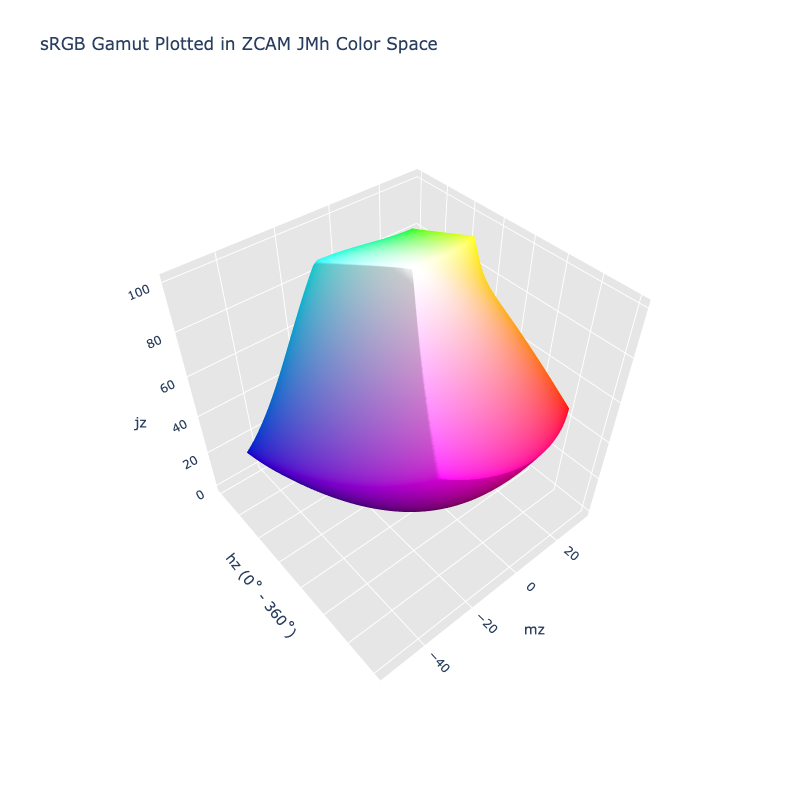ZCAM JMh
The ZCAM JMh color space is not registered in Color by default
Properties
Name: zcam-jmh
White Point: D65 / 2˚
Coordinates:
| Name | Range* |
|---|---|
jz | [0, 100] |
mz | [0, 60] |
hz | [0, 360) |
* Space is not bound to the range and is only used as a reference to define percentage inputs/outputs in relation to the Display P3 color space.

The sRGB gamut represented within the ZCAM JMh color space.
A color appearance model (CAM) is a mathematical model that seeks to describe the perceptual aspects of human color vision, i.e. viewing conditions under which the appearance of a color does not tally with the corresponding physical measurement of the stimulus source.
ZCAM is a CAM model that builds off earlier work done with Jzazbz by Safdar. It uses a Perceptual Quantizer (PQ) curve, developed to uniformly encode a luminance range of 0.001 to 10,000 cd/m2.
The model defines numerous different attributes:
| Name | Description |
|---|---|
| Jz | Lightness |
| Cz | Chroma |
| hz | hue |
| Qz | Brightness |
| Mz | Colorfulness |
| Sz | Saturation |
| Vz | Vividness |
| Kz | Blackness |
| Wz | Whiteness |
| Hz | Hue Quadrature |
A color space can be constructed by using a subset of these attributes: JzCzhz, JzMzhz, QzMzhz, etc. The provided color spaces uses JzMzhz.
Viewing Conditions
ZCAM is a color appearance model and can be configured with different viewing environments. A ZCAM color space will also have an associated environment object. This environment object determines the viewing conditions. Colors will appear different based on the viewing conditions.
| Viewing Conditions | Description |
|---|---|
| White | This is the white point and output white and should be the same as defined in the color class. This is provided as (x, y) chromaticity coordinates. ZCAM expects and was designed for this to be D65. |
| Reference White | The absolute reference white where Yw is scaled to the luminance. |
| Adapting Luminance | The luminance of the adapting field (La). The units are in cd/m2. |
| Background Luminance | The background luminance (Yb) the relative luminance of the nearby background (out to 10°), relative to the the reference white's luminance (Y). Usually 20 providing a gray world assumption. |
| Surround | A description of the peripheral area. Use "dark" for a movie theater, "dim" for e.g. viewing a bright television in a dimly lit room, or "average" for surface colors. |
| Discounting | Discounts the illuminant. If true, the eye is assumed to be fully adapted to the illuminant. Otherwise, the degree of discounting is based on other parameters. When the eye is not fully adapted, it can affect the way colors appear and the chromatic response. |
ColorAide must provide some defaults, so ZCAM comes with a default set of viewing conditions that uses a D65 white point, a reference white that uses D65 scaled to 100, an adapting luminance of 64 lux or a value of ~4 cd/m2, it uses the "gray world" assumption and sets the background to 20, an "average" surround and leaves discounting set to False.
The default settings do not have to be used and a new ZCAM variant with different viewing conditions can be created. When doing this, the space should be derived from the default
>>> from coloraide import Color as Base
>>> from coloraide.spaces.zcam_jmh import ZCAMJMh, Environment
>>> from coloraide.cat import WHITES
>>> from coloraide import util
>>> import math
>>> cdm2 = 1000 / math.pi
>>> class CustomZCAMJMh(ZCAMJMh):
... NAME = "zcam-custom"
... SERIALIZE = ("--zcam-custom",)
... WHITE = WHITES['2deg']['D65']
... ENV = Environment(
... white=WHITE,
... reference_white=[c * cdm2 for c in util.xy_to_xyz(WHITE)],
... adapting_luminance=cdm2,
... background_luminance=100,
... surround='average',
... discounting=False
... )
...
>>> class Color(Base): ...
...
>>> Color.register([ZCAMJMh(), CustomZCAMJMh()])
>>> Color('red').convert('zcam-jmh')
color(--zcam-jmh 51.197 43.776 42.477 / 1)
>>> Color('red').convert('zcam-custom')
color(--zcam-custom 33.959 43.15 42.477 / 1)
Channel Aliases
| Channels | Aliases |
|---|---|
jz | lightness, j |
mz | colorfulness, m |
hz | hue, h |
Input/Output
The ZCAM JMh space is not currently supported in the CSS spec, the parsed input and string output formats use the color() function format using the custom name --zcam-jmh:
color(--zcam-jmh jz mz hz / a) // Color function
The string representation of the color object and the default string output use the color(--zcam-jmh jz mz hz / a) form.
>>> Color("zcam-jmh", [51.197, 43.776, 42.477], 1)
color(--zcam-jmh 51.197 43.776 42.477 / 1)
>>> Color("zcam-jmh", [71.271, 32.313, 75.038], 1).to_string()
'color(--zcam-jmh 71.271 32.313 75.038)'
Registering
from coloraide import Color as Base
from coloraide_extras.spaces.zcam_jmh import ZCAMJMh
class Color(Base): ...
Color.register(ZCAMJMh())